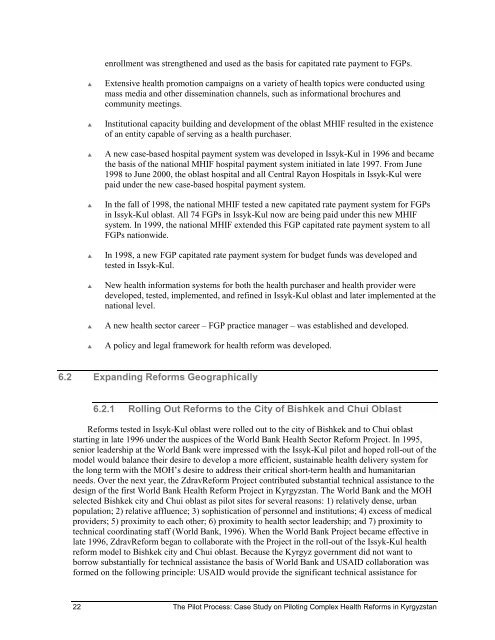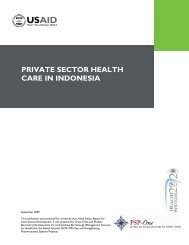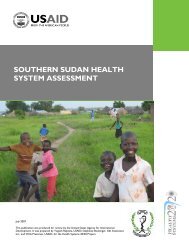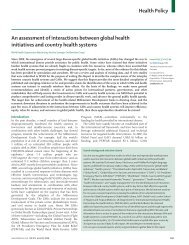Case Study on Piloting Complex Health Reforms in ... - PHRplus
Case Study on Piloting Complex Health Reforms in ... - PHRplus
Case Study on Piloting Complex Health Reforms in ... - PHRplus
Create successful ePaper yourself
Turn your PDF publications into a flip-book with our unique Google optimized e-Paper software.
enrollment was strengthened and used as the basis for capitated rate payment to FGPs.<br />
! Extensive health promoti<strong>on</strong> campaigns <strong>on</strong> a variety of health topics were c<strong>on</strong>ducted us<strong>in</strong>g<br />
mass media and other dissem<strong>in</strong>ati<strong>on</strong> channels, such as <strong>in</strong>formati<strong>on</strong>al brochures and<br />
community meet<strong>in</strong>gs.<br />
! Instituti<strong>on</strong>al capacity build<strong>in</strong>g and development of the oblast MHIF resulted <strong>in</strong> the existence<br />
of an entity capable of serv<strong>in</strong>g as a health purchaser.<br />
! A new case-based hospital payment system was developed <strong>in</strong> Issyk-Kul <strong>in</strong> 1996 and became<br />
the basis of the nati<strong>on</strong>al MHIF hospital payment system <strong>in</strong>itiated <strong>in</strong> late 1997. From June<br />
1998 to June 2000, the oblast hospital and all Central Ray<strong>on</strong> Hospitals <strong>in</strong> Issyk-Kul were<br />
paid under the new case-based hospital payment system.<br />
! In the fall of 1998, the nati<strong>on</strong>al MHIF tested a new capitated rate payment system for FGPs<br />
<strong>in</strong> Issyk-Kul oblast. All 74 FGPs <strong>in</strong> Issyk-Kul now are be<strong>in</strong>g paid under this new MHIF<br />
system. In 1999, the nati<strong>on</strong>al MHIF extended this FGP capitated rate payment system to all<br />
FGPs nati<strong>on</strong>wide.<br />
! In 1998, a new FGP capitated rate payment system for budget funds was developed and<br />
tested <strong>in</strong> Issyk-Kul.<br />
! New health <strong>in</strong>formati<strong>on</strong> systems for both the health purchaser and health provider were<br />
developed, tested, implemented, and ref<strong>in</strong>ed <strong>in</strong> Issyk-Kul oblast and later implemented at the<br />
nati<strong>on</strong>al level.<br />
! A new health sector career – FGP practice manager – was established and developed.<br />
! A policy and legal framework for health reform was developed.<br />
6.2 Expand<strong>in</strong>g <strong>Reforms</strong> Geographically<br />
6.2.1 Roll<strong>in</strong>g Out <strong>Reforms</strong> to the City of Bishkek and Chui Oblast<br />
<strong>Reforms</strong> tested <strong>in</strong> Issyk-Kul oblast were rolled out to the city of Bishkek and to Chui oblast<br />
start<strong>in</strong>g <strong>in</strong> late 1996 under the auspices of the World Bank <strong>Health</strong> Sector Reform Project. In 1995,<br />
senior leadership at the World Bank were impressed with the Issyk-Kul pilot and hoped roll-out of the<br />
model would balance their desire to develop a more efficient, susta<strong>in</strong>able health delivery system for<br />
the l<strong>on</strong>g term with the MOH’s desire to address their critical short-term health and humanitarian<br />
needs. Over the next year, the ZdravReform Project c<strong>on</strong>tributed substantial technical assistance to the<br />
design of the first World Bank <strong>Health</strong> Reform Project <strong>in</strong> Kyrgyzstan. The World Bank and the MOH<br />
selected Bishkek city and Chui oblast as pilot sites for several reas<strong>on</strong>s: 1) relatively dense, urban<br />
populati<strong>on</strong>; 2) relative affluence; 3) sophisticati<strong>on</strong> of pers<strong>on</strong>nel and <strong>in</strong>stituti<strong>on</strong>s; 4) excess of medical<br />
providers; 5) proximity to each other; 6) proximity to health sector leadership; and 7) proximity to<br />
technical coord<strong>in</strong>at<strong>in</strong>g staff (World Bank, 1996). When the World Bank Project became effective <strong>in</strong><br />
late 1996, ZdravReform began to collaborate with the Project <strong>in</strong> the roll-out of the Issyk-Kul health<br />
reform model to Bishkek city and Chui oblast. Because the Kyrgyz government did not want to<br />
borrow substantially for technical assistance the basis of World Bank and USAID collaborati<strong>on</strong> was<br />
formed <strong>on</strong> the follow<strong>in</strong>g pr<strong>in</strong>ciple: USAID would provide the significant technical assistance for<br />
22 The Pilot Process: <str<strong>on</strong>g>Case</str<strong>on</strong>g> <str<strong>on</strong>g>Study</str<strong>on</strong>g> <strong>on</strong> <strong>Pilot<strong>in</strong>g</strong> <strong>Complex</strong> <strong>Health</strong> <strong>Reforms</strong> <strong>in</strong> Kyrgyzstan

















